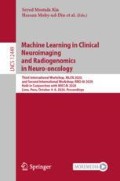Abstract
The cerebral cortex performs higher-order brain functions and is thus implicated in a range of cognitive disorders. Current analysis of cortical variation is typically performed by fitting surface mesh models to inner and outer cortical boundaries and investigating metrics such as surface area and cortical curvature or thickness. These, however, take a long time to run, and are sensitive to motion and image and surface resolution, which can prohibit their use in clinical settings. In this paper, we instead propose a machine learning solution, training a novel architecture to predict cortical thickness and curvature metrics from T2 MRI images, while additionally returning metrics of prediction uncertainty. Our proposed model is tested on a clinical cohort (Down Syndrome) for which surface-based modelling often fails. Results suggest that deep convolutional neural networks are a viable option to predict cortical metrics across a range of brain development stages and pathologies.
Access this chapter
Tax calculation will be finalised at checkout
Purchases are for personal use only
References
Baumgartner, C.F., et al.: PHiSeg: capturing uncertainty in medical image segmentation. In: Shen, D., et al. (eds.) MICCAI 2019. LNCS, vol. 11765, pp. 119–127. Springer, Cham (2019). https://doi.org/10.1007/978-3-030-32245-8_14
Budd, S., et al.: Confident head circumference measurement from ultrasound with real-time feedback for sonographers. In: Shen, D., et al. (eds.) MICCAI 2019. LNCS, vol. 11767, pp. 683–691. Springer, Cham (2019). https://doi.org/10.1007/978-3-030-32251-9_75
Çiçek, Ö., Abdulkadir, A., Lienkamp, S.S., Brox, T., Ronneberger, O.: 3D U-Net: learning dense volumetric segmentation from sparse annotation. In: Ourselin, S., Joskowicz, L., Sabuncu, M.R., Unal, G., Wells, W. (eds.) MICCAI 2016. LNCS, vol. 9901, pp. 424–432. Springer, Cham (2016). https://doi.org/10.1007/978-3-319-46723-8_49
Dahnke, R., Yotter, R.A., Gaser, C.: Cortical thickness and central surface estimation. NeuroImage 65, 336–348 (2013). https://doi.org/10.1016/j.neuroimage.2012.09.050, http://www.ncbi.nlm.nih.gov/pubmed/23041529
Das, S.R., Avants, B.B., Grossman, M., Gee, J.C.: Registration based cortical thickness measurement. NeuroImage 45(3), 867–879 (2009). https://doi.org/10.1016/j.neuroimage.2008.12.016
Elsken, T., Metzen, J.H., Hutter, F.: Neural architecture search: a survey. J. Mach. Learn. Res. 20 (2018). http://arxiv.org/abs/1808.05377
Fischl, B., Dale, A.M.: Measuring the thickness of the human cerebral cortex from magnetic resonance images. Proc. Natl. Acad. Sci. United States Am. 97(20), 11050–11055 (2000). https://doi.org/10.1073/pnas.200033797
Ghiasi, G., Lin, T.Y., Le, Q.V.: DropBlock: a regularization method for convolutional networks. In: Advances in Neural Information Processing Systems 2018-December, pp. 10727–10737 (2018). http://arxiv.org/abs/1810.12890
Glasser, M.F., et al.: The minimal preprocessing pipelines for the Human Connectome Project. NeuroImage (2013). https://doi.org/10.1016/j.neuroimage.2013.04.127
Glasser, M.F., et al.: A multi-modal parcellation of human cerebral cortex. Nat. Publishing Group 536, 171–178 (2016). https://doi.org/10.1038/nature18933
Huber, P.J.: Robust estimation of a location parameter. Ann. Math. Stat. 35(1), 73–101 (1964). https://doi.org/10.1214/AOMS/1177703732
Hughes, E.J., et al.: A dedicated neonatal brain imaging system. Magn. Reson. Med. 78(2), 794–804 (2017). https://doi.org/10.1002/mrm.26462
Kohl, S., et al.: A probabilistic U-Net for segmentation of ambiguous images. In: Advances in Neural Information Processing Systems, pp. 6965–6975 (2018)
Lee, N.R., et al.: Dissociations in cortical morphometry in youth with down syndrome: evidence for reduced surface area but increased thickness. Cerebral Cortex (New York, N.Y.: 1991) 26(7), 2982–2990 (2016). https://doi.org/10.1093/cercor/bhv107, http://www.ncbi.nlm.nih.gov/pubmed/26088974 www.pubmedcentral.nih.gov/articlerender.fcgi?artid=PMC4898663
Leventer, R.J., Guerrini, R., Dobyns, W.B.: Malformations of cortical development and epilepsy (2008)
Makropoulos, A., et al.: The developing human connectome project: a minimal processing pipeline for neonatal cortical surface reconstruction. NeuroImage 173, 88–112 (2018). https://doi.org/10.1016/j.neuroimage.2018.01.054
Marcus, D.S., et al.: Informatics and data mining tools and strategies for the human connectome project. Front. Neuroinf. 5, 4 (2011). https://doi.org/10.3389/fninf.2011.00004, http://journal.frontiersin.org/article/10.3389/fninf.2011.00004/abstract
Mukherjee, P., et al.: Disconnection between amygdala and medial prefrontal cortex in psychotic disorders. Schizophrenia bull. 42(4), 1056–167 (2016). https://doi.org/10.1093/schbul/sbw012, http://www.ncbi.nlm.nih.gov/pubmed/26908926 www.pubmedcentral.nih.gov/articlerender.fcgi?artid=PMC4903065
Ronneberger, O., Fischer, P., Brox, T.: U-Net: convolutional networks for biomedical image segmentation. In: Navab, N., Hornegger, J., Wells, W.M., Frangi, A.F. (eds.) MICCAI 2015. LNCS, vol. 9351, pp. 234–241. Springer, Cham (2015). https://doi.org/10.1007/978-3-319-24574-4_28
Tustison, N.J., et al.: Large-scale evaluation of ANTs and FreeSurfer cortical thickness measurements. NeuroImage 99, 166–179 (2014). https://doi.org/10.1016/j.neuroimage.2014.05.044
Yang, D.Y., Beam, D., Pelphrey, K.A., Abdullahi, S., Jou, R.J.: Cortical morphological markers in children with autism: a structural magnetic resonance imaging study of thickness, area, volume, and gyrification. Molec. Autism 7(1), 11 (2016). https://doi.org/10.1186/s13229-016-0076-x, http://molecularautism.biomedcentral.com/articles/10.1186/s13229-016-0076-x
Acknowledgements
We thank the parents and children who participated in this study. This work was supported by the Medical Research Council [MR/K006355/1]; Rosetrees Trust [A1563], Fondation Jérôme Lejeune [2017b – 1707], Sparks and Great Ormond Street Hospital Children’s Charity [V5318]. The research leading to these results has received funding from the European Research Council under the European Unions Seventh Framework Programme (FP/2007–2013)/ERC Grant Agreement no. 319456. The work of E.C.R. was supported by the Academy of Medical Sciences/the British Heart Foundation/the Government Department of Business, Energy and Industrial Strategy/the Wellcome Trust Springboard Award [SBF003/1116]. We also gratefully acknowledge financial support from the Wellcome Trust IEH 102431, EPSRC (EP/S022104/1, EP/S013687/1), EPSRC Centre for Medical Engineering [WT 203148/Z/16/Z], the National Institute for Health Research (NIHR) Biomedical Research Centre (BRC) based at Guy’s and St Thomas’ NHS Foundation Trust and King’s College London and supported by the NIHR Clinical Research Facility (CRF) at Guy’s and St Thomas’, and Nvidia GPU donations.
Author information
Authors and Affiliations
Corresponding author
Editor information
Editors and Affiliations
1 Electronic supplementary material
Below is the link to the electronic supplementary material.
Rights and permissions
Copyright information
© 2020 Springer Nature Switzerland AG
About this paper
Cite this paper
Budd, S., Patkee, P., Baburamani, A., Rutherford, M., Robinson, E.C., Kainz, B. (2020). Surface Agnostic Metrics for Cortical Volume Segmentation and Regression. In: Kia, S.M., et al. Machine Learning in Clinical Neuroimaging and Radiogenomics in Neuro-oncology. MLCN RNO-AI 2020 2020. Lecture Notes in Computer Science(), vol 12449. Springer, Cham. https://doi.org/10.1007/978-3-030-66843-3_1
Download citation
DOI: https://doi.org/10.1007/978-3-030-66843-3_1
Published:
Publisher Name: Springer, Cham
Print ISBN: 978-3-030-66842-6
Online ISBN: 978-3-030-66843-3
eBook Packages: Computer ScienceComputer Science (R0)


